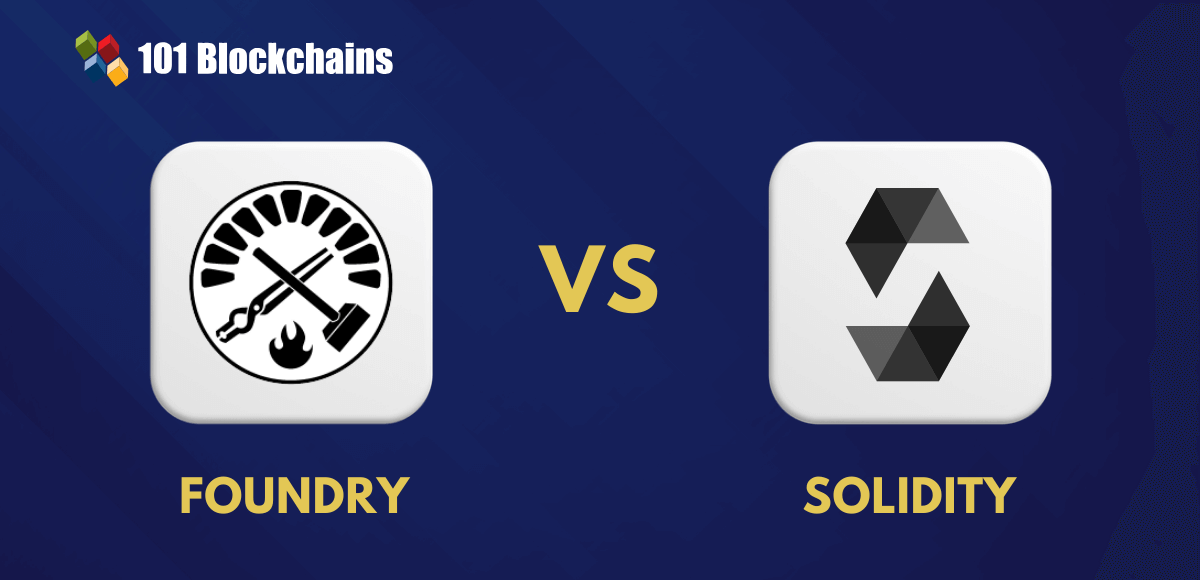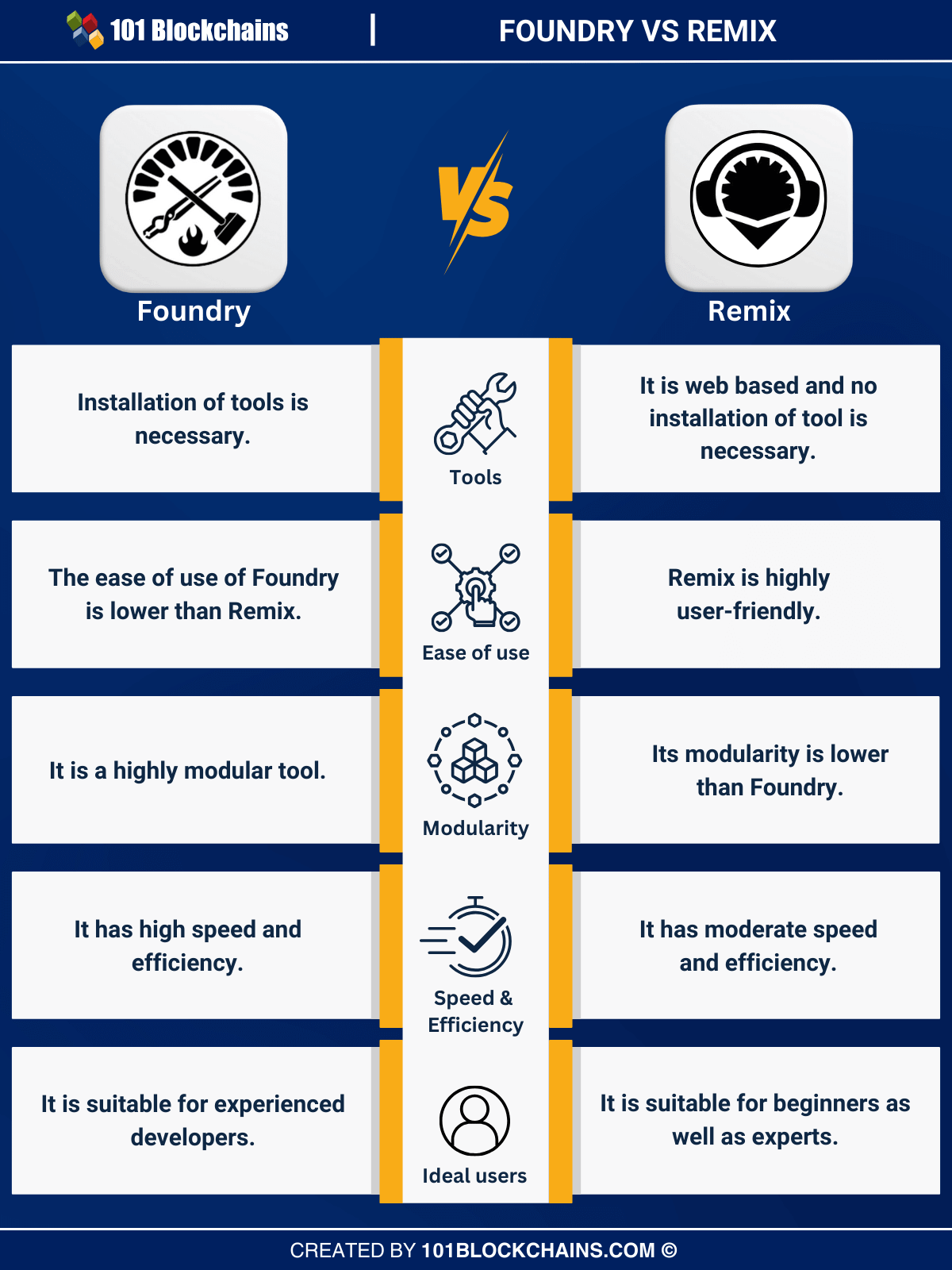
The blockchain landscape is undergoing unprecedented change in the technology-driven times. Some of the names that have captured the attention of the members of the blockchain community are foundry and remix. The emergence of both foundry and remix has been nothing less than revolutionary. This is because these toolkits can be used to develop as well as deploy smart contracts within the Ethereum network.
In order to get a comprehensive insight into Ethereum blockchain, having an in-depth insight into the remix and foundry frameworks is a must. These toolchains have the potential to redefine the process of smart contract development and deployment processes within Ethereum.
Apart from understanding foundry and remix at the conceptual level, you must understand the differences that exist between them. The insight can undoubtedly help you use these toolkits in the practical setting as a blockchain professional. Let us learn about the foundry vs remix comparison now.
Build your identity as a certified blockchain expert with 101 Blockchains’ Blockchain Certifications designed to provide enhanced career prospects.
An insight into Foundry
In the blockchain realm, Foundry has been introduced as a toolchain that can be used for developing smart contracts. You can use Foundry for a broad range of purposes such as managing your dependencies, compiling your project, and performing tests. Foundry serves as a valuable and indispensable tool for developers which can help them to develop new applications within the Ethereum blockchain.
A distinguishing feature of foundry is that it offers a set of tools to developers that can assist them in development processes. That’s not all! Foundry also offers a suitable ecosystem that can simplify the development process. The highly convenient and modular toolkit has been written using the Rust programming language. Within a short span of time, Foundry has gained immense popularity due to its key features such as high accessibility, simple installation process, and absence of any complex configurations.
An insight into Remix
Remix serves as a rich toolset that has been developed to simplify the journey of developers while working on smart contract development. Remix can be used by developers regardless of their level of knowledge and expertise in the Ethereum realm. It is immensely popular among developers since it can be used as a learning lab for the purpose of experimenting within the Ethereum blockchain.
Both novice as well as experts can use Remix for developing smart contracts in Ethereum. This is because the development as well as deployment process is pretty simple. Due to the simplicity that is associated with remix, it is considered to be the ultimate framework that can be used for learning Ethereum. You can directly start using the framework without requiring any kind of set up. Moreover, the intuitive and flexible use interface makes it immensely popular among developers working within the Ethereum ecosystem.
Now that you have a basic understanding of both remix and foundry, it is time to explore them at a deeper level. Although both the toolkits are popular in the Ethereum blockchain, an insight into foundry vs remix is essential. By understanding the difference between foundry and remix you can optimally use them to develop smart contracts.
Main differences between Foundry and Remix
If you wish to broaden your insight into Ethereum blockchain, you must have a clear understanding of the difference between foundry and remix. Both foundry and remix act as competitors of each other. Below are some of the key aspects that can help you broaden your knowledge on foundry vs remix.
A major difference between foundry and remix arises because of the use of varying tools. In the case of Foundry, a combination of command line interface tools is made available to users and developers. These specific tools suit users who prefer working in terminal environments.
You need to install the tools so that you can use them to develop smart contracts. By leveraging the set of tools, you can effortlessly streamline your smart contract development workflow. Furthermore, automated testing in Foundry can simplify the development process for you within the Ethereum landscape.
The Remix framework fundamentally involves an integrated development environment (IDE) that is web based. By using the toolkit developers will be able to make use of a graphical user interface for the purpose of handling the entire lifecycle of smart contracts. You can easily access it via the web if you have an internet connection.
It is true that both remix and foundry are widely popular, and they have their respective users and supporters. However, when it comes to ease of use, Remix gains an upper hand over Foundry. Although experienced blockchain developers may find Foundry easy and convenient, the same cannot be said for beginners. The robust set of tools of Foundry may overwhelm you if you are a novice developer.
However, Remix has the reputation of being immensely user-friendly. Because of this feature it is extremely popular as a learning resource or lab where new developers can develop their smart contract development skills. Thus, user-friendliness or ease of use is a key thing to consider in order to understand foundry vs remix.
Foundry is undoubtedly a highly modular tool in comparison to remix. Due to the modular aspect, it offers ample flexibility to developers within the Ethereum blockchain realm. You can utilize the specific components of the toolchain that are of relevance to you. Due to this particular dimension, developers can integrate Foundry with other tools as per their needs.
However, the same is not the case when it comes to Remix. The tools as well as abstractions offered by remix do not have the modularity that is offered by Foundry. As a result the ability of developers to flexibly engage in the development process may get restricted. It is a key component that you must bear in mind to understand remix vs foundry.
Learn about the basic concepts of Ethereum, such as transactions, addresses, consensus, blocks, and important tools with the Ethereum Technology Course.
-
Speed and efficiency of the development frameworks
There exists a considerable difference between foundry and remix in terms of speed and efficiency. Since the foundry framework is based on Rust, its execution is highly efficient and quick. However, the level of speed and efficiency of Remix is moderate. This is because it is a web-based toolkit. Due to such an interface, there may arise restrictions in its efficiency which may be seen as a hindrance for expert developers.
-
Ideal users of the toolchains
If you wish to explore foundry vs remix thoroughly, you need to identify the ideal users of each of the frameworks. Foundry is suitable for experienced developers. If you like using command line interface or CLI tools, Foundry is perfect for you. By leveraging the powerful toolkit, you can engage in efficient, and fast development, testing and deployment processes. The modular nature of Foundry certainly makes it highly valuable for experts in the Ethereum blockchain.
On the other hand, Remix is ideal for both beginners and experts. Beginners are most likely to prefer it since it offers the right combination of tools to learn and explore Ethereum. In fact, educators can use Remix to educate blockchain developers who wish to learn how to develop smart contracts.
You need to understand the differences that exist between foundry and remix if you wish to operate and excel in the blockchain realm. By having a clear insight into remix vs foundry, you can apply these toolkits to develop smart contracts within Ethereum.
Below is a brief overview of the key differences between Foundry and Remix:

Indispensable role of Smart Contracts
Within the blockchain ecosystem, the role of smart contracts is indispensable. In fact, they serve as self-executing programs that facilitate the automation of blockchain transactions. The role of smart contracts is key to ensure the transactions are irreversible as well as traceable. Currently numerous developments are taking place in the blockchain arena, especially relating to smart contracts.
The development of Remix and Foundry give a glimpse into how far the smart contract development process has come today. Developers can certainly leverage the tools that come with these development frameworks in order to develop solid smart contracts.
However, for optimally using these toolchains it is fundamental to know about remix vs foundry. By knowing the key differences between these development frameworks, you can make their optimum use while developing smart contracts. The knowledge can come in handy for you as a blockchain developer.
Familiarize yourself with the complete Ethereum smart contract development lifecycle and gain fluency in the best practices for smart contract coding, testing, and deployment with Smart Contracts Development Course.
Final Thoughts
Foundry and Remix are innovative smart contract development toolchains that exist today. Blockchain developers need to have a solid comprehension of these tools so that they can effectively use them in the practical setting. The strategic use of these toolchains can help to optimally develop as well as deploy smart contracts within the Ethereum networks. You need to know how Foundry and Remix come in handy in the smart contract development context.
Moreover, you must also have clarity on the differences that exist between Foundry and Remix. The knowledge can certainly help you effectively use the tool sets in the Ethereum blockchain setting. You must keep in mind that both the development toolchains have their respective strengths, and unique features. You can further learn how Foundry and Remix can help blockchain developers in their smart contract development journey.



